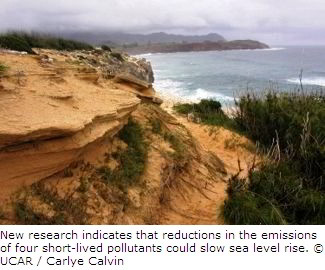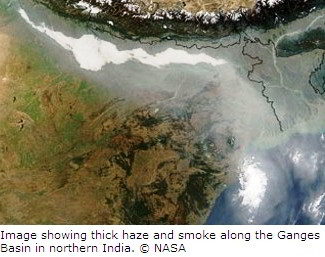 Source: UCAR and NSF
Source: UCAR and NSF
Authors: Aixue Hu, et al.
Topic Area: Emissions Reduction, Sea Level Rise
Geographic Area: Coastal Cities
Boulder – With coastal areas bracing for rising sea levels, new research indicates that cutting emissions of certain pollutants can greatly slow down sea level rise this century.
The research team found that reductions in four pollutants that cycle comparatively quickly through the atmosphere could slow the annual rate of sea level rise by roughly 25 to 50 percent.
“To avoid potentially dangerous sea level rise, we could cut emissions of short-lived pollutants even if we cannot immediately cut carbon dioxide emissions,” says Aixue Hu of the National Center for Atmospheric Research (NCAR), the first author of the study. “This new research shows that society can significantly reduce the threat to coastal cities if it moves quickly on a handful of pollutants.”
The study, a collaboration of the Scripps Institution for Oceanography, NCAR, and Climate Central, was published on April 14 in the journal Nature Climate Change. It was funded by the National Science Foundation (NSF) and the U.S. Department of Energy.
“It is still not too late, by stabilizing carbon dioxide concentrations in the atmosphere and reducing emissions of shorter-lived pollutants, to lower the rate of warming and reduce sea level rise by 30 percent,” says Veerabhadran Ramanathan of Scripps, who led the study. “The large role of the shorter-lived pollutants is encouraging since technologies are available to drastically cut their emissions.”
Protecting the Coasts
The potential impact of rising oceans on populated areas is one of the most concerning effects of climate change. Many of the world’s major cities, such as New York, Miami, Amsterdam, Mumbai and Tokyo, are located in low-lying areas by the water.
As glaciers and ice sheets melt and warming oceans expand, sea levels have been rising by an average of about 3 millimetres annually in recent years (just more than one-tenth of an inch). If temperatures continue to warm, sea levels are projected to rise between 18 and 200 centimetres (between 7 inches and 6 feet) this century, according to reports by the Intergovernmental Panel on Climate Change (IPCC) and the U.S. National Research Council.
Such an increase could submerge densely populated coastal communities, especially when storm surges hit.
Despite the risks, policy makers have been unable to agree on procedures for reducing emissions of carbon dioxide, which is the main human-emitted greenhouse gas. With this in mind, the research team focused on emissions of four other heat-trapping pollutants: methane, soot, refrigerants, and gases that lead to the formation of ground-level ozone. These gases and particles last anywhere from a week to a decade in the atmosphere, and they can influence climate more quickly than carbon dioxide, which persists in the atmosphere for more than a century.
Previous research by Ramanathan and Yangyang Xu of Scripps, a co-author of the new paper, has shown that a sharp reduction in emissions of these shorter-lived pollutants beginning in 2015 could offset warming temperatures by up to 50 percent by 2050.
Applying those emission reductions to sea level rise, the new research found that the cuts could dramatically slow rising sea levels. Their results showed that total sea level rise would be reduced by an estimated 22 to 42 percent by 2100, depending on the extent to which emissions were reduced.
However, the new study also found that delaying emissions cuts until 2040 would reduce the beneficial impact on year-2100 sea level rise by about a third.
If society were able to substantially reduce both emissions of carbon dioxide as well as the four other pollutants, total sea level rise would be lessened by at least 30 percent by 2100, the researchers concluded.
The researchers used mostly percentage changes for sea level rise, rather than actual estimates in centimetres, because of uncertainties over future temperature increases and their impacts on rising sea levels.
“We still have some control over the amount of sea level rise that we are facing,” Hu says.
 Another co-author, Claudia Tebaldi of Climate Central, adds, “Without diminishing the importance of reducing carbon dioxide emissions in the long term, this study shows that more immediate gains from shorter-lived pollutants are substantial. Cutting emissions of those gases could give coastal communities more time to prepare for rising sea levels. As we have seen recently, storm surges in very highly populated regions of the East Coast show the importance of both making such preparations and cutting greenhouse gases.”
Another co-author, Claudia Tebaldi of Climate Central, adds, “Without diminishing the importance of reducing carbon dioxide emissions in the long term, this study shows that more immediate gains from shorter-lived pollutants are substantial. Cutting emissions of those gases could give coastal communities more time to prepare for rising sea levels. As we have seen recently, storm surges in very highly populated regions of the East Coast show the importance of both making such preparations and cutting greenhouse gases.”
To conduct the study, Hu and his colleagues turned to the NCAR-based Community Climate System Model, as well as a second computer model that simulates climate, carbon, and geochemistry. They also drew on estimates of future emissions of heat-trapping gases under various social and economic scenarios and on computer models of melting ice and sea level rise.
The study assumes that society could reduce emissions of the four gases and particles by 30 to 60 percent over the next several decades. That is the steepest reduction believed achievable by economists who have studied the issue at Austria’s International Institute for Applied Systems Analysis, one of the world’s leading research centers into the impact of economic activity on climate change.
“It must be remembered that carbon dioxide is still the most important factor in sea level rise over the long term,” says NCAR scientist Warren Washington, a co-author. “But we can make a real difference in the next several decades by reducing other emissions.”
Source: UCAR and NSF.

















